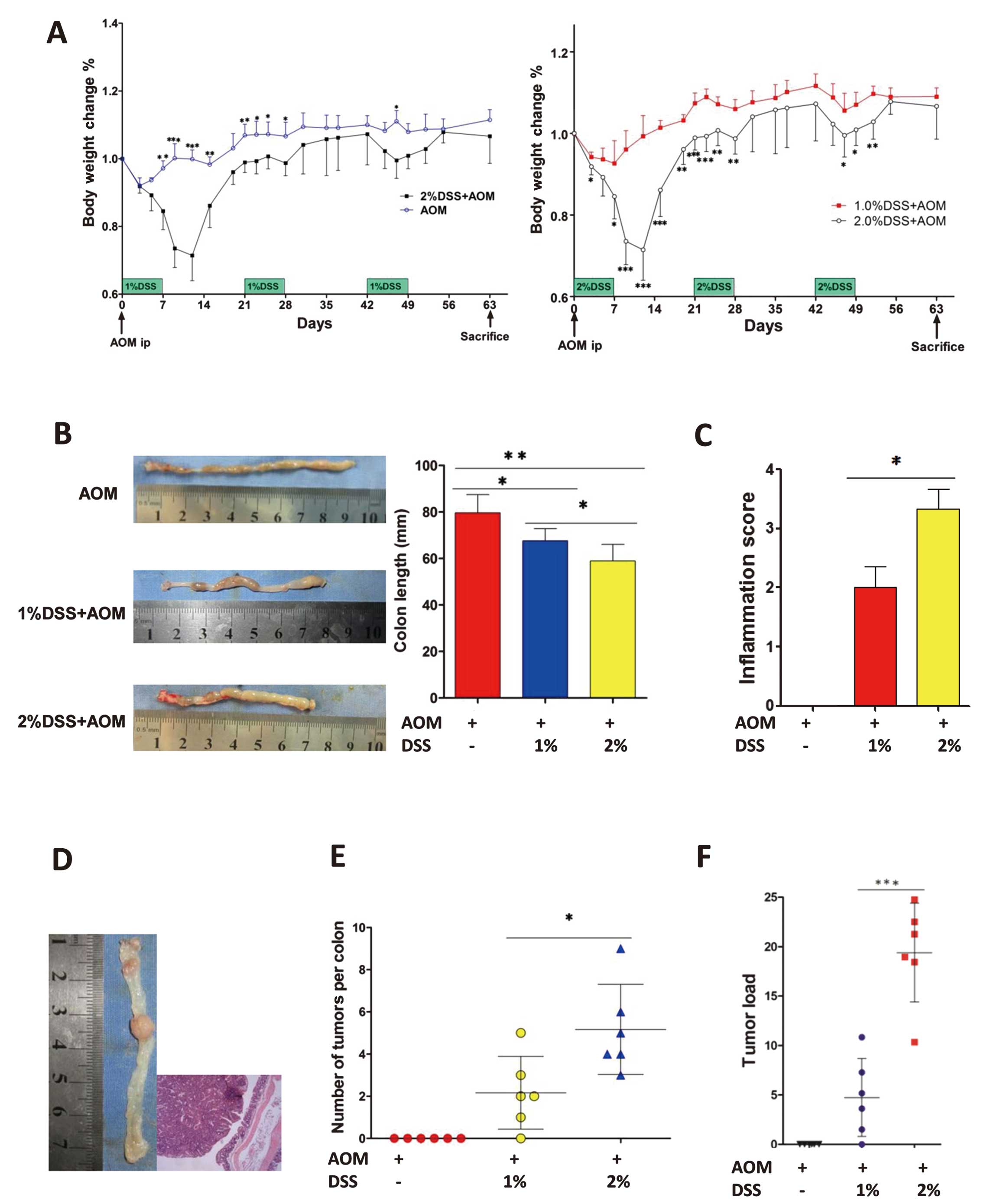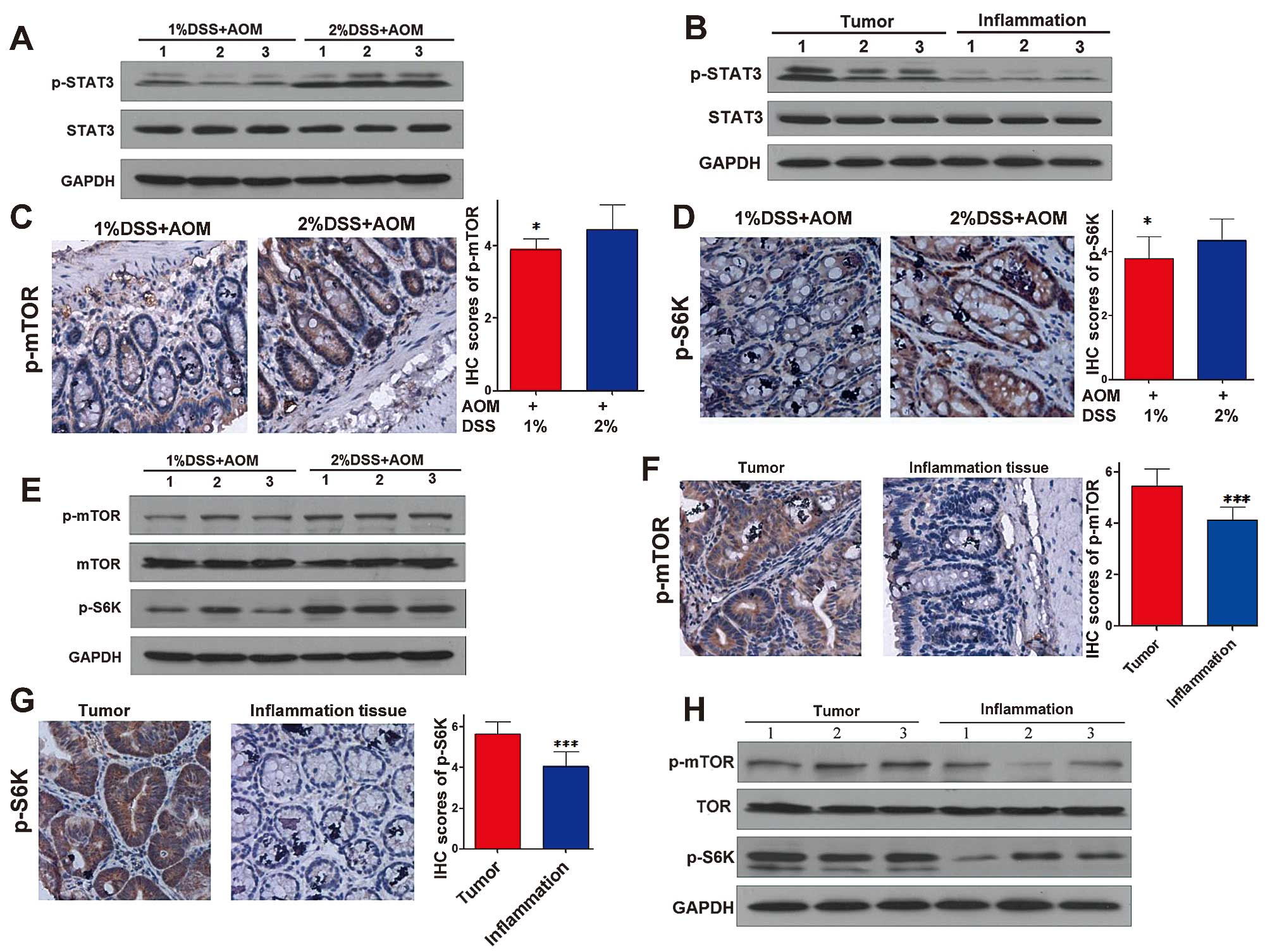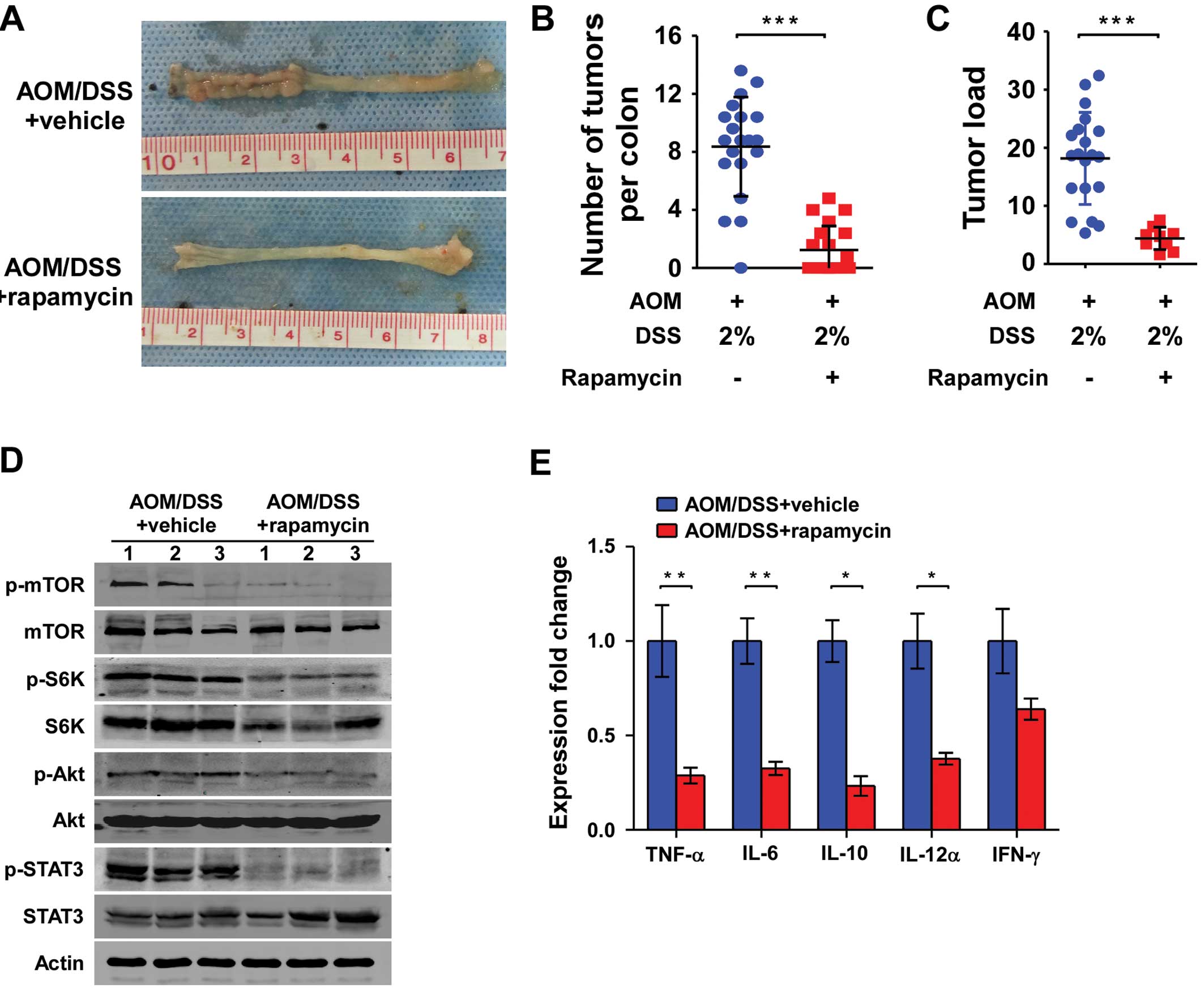|
1
|
Balkwill F and Mantovani A: Inflammation
and cancer: back to Virchow? Lancet. 357:539–545. 2001. View Article : Google Scholar : PubMed/NCBI
|
|
2
|
Eaden JA, Abrams KR and Mayberry JF: The
risk of colorectal cancer in ulcerative colitis: a meta-analysis.
Gut. 48:526–535. 2001. View Article : Google Scholar : PubMed/NCBI
|
|
3
|
Gillen CD, Walmsley RS, Prior P, Andrews
HA and Allan RN: Ulcerative colitis and Crohn’s disease: a
comparison of the colorectal cancer risk in extensive colitis. Gut.
35:1590–1592. 1994.
|
|
4
|
Saleh M and Trinchieri G: Innate immune
mechanisms of colitis and colitis-associated colorectal cancer. Nat
Rev Immunol. 11:9–20. 2011. View
Article : Google Scholar
|
|
5
|
Rhodes JM: Unifying hypothesis for
inflammatory bowel disease and associated colon cancer: sticking
the pieces together with sugar. Lancet. 347:40–44. 1996. View Article : Google Scholar : PubMed/NCBI
|
|
6
|
Rutter M, Saunders B, Wilkinson K, et al:
Severity of inflammation is a risk factor for colorectal neoplasia
in ulcerative colitis. Gastroenterology. 126:451–459. 2004.
View Article : Google Scholar : PubMed/NCBI
|
|
7
|
Strimpakos AS, Karapanagiotou EM, Saif MW
and Syrigos KN: The role of mTOR in the management of solid tumors:
an overview. Cancer Treat Rev. 35:148–159. 2009. View Article : Google Scholar : PubMed/NCBI
|
|
8
|
Guertin DA and Sabatini DM: Defining the
role of mTOR in cancer. Cancer Cell. 12:9–22. 2007. View Article : Google Scholar
|
|
9
|
Hay N and Sonenberg N: Upstream and
downstream of mTOR. Genes Dev. 18:1926–1945. 2004. View Article : Google Scholar
|
|
10
|
Delgoffe GM and Powell JD: mTOR: taking
cues from the immune microenvironment. Immunology. 127:459–465.
2009. View Article : Google Scholar : PubMed/NCBI
|
|
11
|
Magnuson B, Ekim B and Fingar DC:
Regulation and function of ribosomal protein S6 kinase (S6K) within
mTOR signalling networks. Biochem J. 441:1–21. 2012. View Article : Google Scholar : PubMed/NCBI
|
|
12
|
Jastrzebski K, Hannan KM, Tchoubrieva EB,
Hannan RD and Pearson RB: Coordinate regulation of ribosome
biogenesis and function by the ribosomal protein S6 kinase, a key
mediator of mTOR function. Growth Factors. 25:209–226. 2007.
View Article : Google Scholar : PubMed/NCBI
|
|
13
|
Duvel K, Yecies JL, Menon S, et al:
Activation of a metabolic gene regulatory network downstream of
mTOR complex 1. Mol Cell. 39:171–183. 2010. View Article : Google Scholar : PubMed/NCBI
|
|
14
|
Guertin DA and Sabatini DM: An expanding
role for mTOR in cancer. Trends Mol Med. 11:353–361. 2005.
View Article : Google Scholar : PubMed/NCBI
|
|
15
|
Sarbassov DD, Ali SM, Sengupta S, et al:
Prolonged rapamycin treatment inhibits mTORC2 assembly and Akt/PKB.
Mol Cell. 22:159–168. 2006. View Article : Google Scholar : PubMed/NCBI
|
|
16
|
Bjornsti MA and Houghton PJ: The TOR
pathway: a target for cancer therapy. Nat Rev Cancer. 4:335–348.
2004. View
Article : Google Scholar : PubMed/NCBI
|
|
17
|
Thiem S, Pierce TP, Palmieri M, et al:
mTORC1 inhibition restricts inflammation-associated
gastrointestinal tumorigenesis in mice. J Clin Invest. 123:767–781.
2013.PubMed/NCBI
|
|
18
|
Yu H, Pardoll D and Jove R: STATs in
cancer inflammation and immunity: a leading role for STAT3. Nat Rev
Cancer. 9:798–809. 2009. View
Article : Google Scholar : PubMed/NCBI
|
|
19
|
Grivennikov S, Karin E, Terzic J, et al:
IL-6 and Stat3 are required for survival of intestinal epithelial
cells and development of colitis-associated cancer. Cancer Cell.
15:103–113. 2009. View Article : Google Scholar : PubMed/NCBI
|
|
20
|
Chumanevich AA, Poudyal D, Cui X, et al:
Suppression of colitis-driven colon cancer in mice by a novel small
molecule inhibitor of sphingosine kinase. Carcinogenesis.
31:1787–1793. 2010. View Article : Google Scholar : PubMed/NCBI
|
|
21
|
Namba R, Young LJ, Abbey CK, et al:
Rapamycin inhibits growth of premalignant and malignant mammary
lesions in a mouse model of ductal carcinoma in situ. Clin Cancer
Res. 12:2613–2621. 2006. View Article : Google Scholar : PubMed/NCBI
|
|
22
|
Yu H, Kortylewski M and Pardoll D:
Crosstalk between cancer and immune cells: role of STAT3 in the
tumour microenvironment. Nat Rev Immunol. 7:41–51. 2007. View Article : Google Scholar : PubMed/NCBI
|
|
23
|
Park E, Park J, Han SW, et al: NVP-BKM120,
a novel PI3K inhibitor, shows synergism with a STAT3 inhibitor in
human gastric cancer cells harboring KRAS mutations. Int J Oncol.
40:1259–1266. 2012.PubMed/NCBI
|
|
24
|
Farraye FA, Odze RD, Eaden J and Itzkowitz
SH: AGA technical review on the diagnosis and management of
colorectal neoplasia in inflammatory bowel disease.
Gastroenterology. 138:746–774.e4. 2010. View Article : Google Scholar : PubMed/NCBI
|
|
25
|
Gupta RB, Harpaz N, Itzkowitz S, et al:
Histologic inflammation is a risk factor for progression to
colorectal neoplasia in ulcerative colitis: a cohort study.
Gastroenterology. 133:1099–1105. 2007. View Article : Google Scholar : PubMed/NCBI
|
|
26
|
Sobala A, Herbst F, Novacek G and
Vogelsang H: Colorectal carcinoma and preceding fistula in Crohn’s
disease. J Crohns Colitis. 4:189–193. 2010.
|
|
27
|
Laukoetter MG, Mennigen R, Hannig CM, et
al: Intestinal cancer risk in Crohn’s disease: a meta-analysis. J
Gastrointest Surg. 15:576–583. 2011.
|
|
28
|
van Staa TP, Card T, Logan RF and Leufkens
HG: 5-Aminosalicylate use and colorectal cancer risk in
inflammatory bowel disease: a large epidemiological study. Gut.
54:1573–1578. 2005.PubMed/NCBI
|
|
29
|
Rubin DT, LoSavio A, Yadron N, Huo D and
Hanauer SB: Aminosalicylate therapy in the prevention of dysplasia
and colorectal cancer in ulcerative colitis. Clin Gastroenterol
Hepatol. 4:1346–1350. 2006. View Article : Google Scholar : PubMed/NCBI
|
|
30
|
Slomovitz BM and Coleman RL: The
PI3K/AKT/mTOR pathway as a therapeutic target in endometrial
cancer. Clin Cancer Res. 18:5856–5864. 2012. View Article : Google Scholar : PubMed/NCBI
|
|
31
|
Lauring J, Park BH and Wolff AC: The
phosphoinositide-3-kinase-Akt-mTOR pathway as a therapeutic target
in breast cancer. J Natl Compr Cancer Netw. 11:670–678.
2013.PubMed/NCBI
|
|
32
|
Lee YK, Park SY, Kim YM, et al:
Suppression of mTOR via Akt-dependent and -independent mechanisms
in selenium-treated colon cancer cells: involvement of AMPKα1.
Carcinogenesis. 31:1092–1099. 2010.PubMed/NCBI
|
|
33
|
Zhang DM, Liu JS, Deng LJ, et al:
Arenobufagin, a natural bufadienolide from toad venom, induces
apoptosis and autophagy in human hepatocellular carcinoma cells
through inhibition of PI3K/Akt/mTOR pathway. Carcinogenesis.
34:1331–1342. 2013. View Article : Google Scholar
|
|
34
|
Smrz D, Kim MS, Zhang S, et al: mTORC1 and
mTORC2 differentially regulate homeostasis of neoplastic and
non-neoplastic human mast cells. Blood. 118:6803–6813. 2011.
View Article : Google Scholar : PubMed/NCBI
|
|
35
|
Fox R, Nhan TQ, Law GL, Morris DR, Liles
WC and Schwartz SM: PSGL-1 and mTOR regulate translation of ROCK-1
and physiological functions of macrophages. EMBO J. 26:505–515.
2007. View Article : Google Scholar : PubMed/NCBI
|
|
36
|
Kawauchi K, Ihjima K and Yamada O: IL-2
increases human telomerase reverse transcriptase activity
transcriptionally and posttranslationally through
phosphatidylinositol 3′-kinase/Akt, heat shock protein 90, and
mammalian target of rapamycin in transformed NK cells. J Immunol.
174:5261–5269. 2005.PubMed/NCBI
|
|
37
|
Donahue AC and Fruman DA: Proliferation
and survival of activated B cells requires sustained antigen
receptor engagement and phosphoinositide 3-kinase activation. J
Immunol. 170:5851–5860. 2003. View Article : Google Scholar : PubMed/NCBI
|
|
38
|
Powell JD and Delgoffe GM: The mammalian
target of rapamycin: linking T cell differentiation, function, and
metabolism. Immunity. 33:301–311. 2010. View Article : Google Scholar : PubMed/NCBI
|
|
39
|
Memmott RM and Dennis PA: The role of the
Akt/mTOR pathway in tobacco carcinogen-induced lung tumorigenesis.
Clin Cancer Res. 16:4–10. 2010. View Article : Google Scholar : PubMed/NCBI
|
|
40
|
Ma J, Meng Y, Kwiatkowski DJ, et al:
Mammalian target of rapamycin regulates murine and human cell
differentiation through STAT3/p63/Jagged/Notch cascade. J Clin
Invest. 120:103–114. 2010. View
Article : Google Scholar : PubMed/NCBI
|
|
41
|
Farkas S, Hornung M, Sattler C, et al:
Rapamycin decreases leukocyte migration in vivo and
effectively reduces experimentally induced chronic colitis. Int J
Colorectal Dis. 21:747–753. 2006.PubMed/NCBI
|
|
42
|
Deng L, Zhou JF, Sellers RS, et al: A
novel mouse model of inflammatory bowel disease links mammalian
target of rapamycin-dependent hyperproliferation of colonic
epithelium to inflammation-associated tumorigenesis. Am J Pathol.
176:952–967. 2010. View Article : Google Scholar
|
|
43
|
Wu Y and Zhou BP: TNF-α/NF-κB/Snail
pathway in cancer cell migration and invasion. Br J Cancer.
102:639–644. 2010.
|
|
44
|
Hodge DR, Hurt EM and Farrar WL: The role
of IL-6 and STAT3 in inflammation and cancer. Eur J Cancer.
41:2502–2512. 2005. View Article : Google Scholar : PubMed/NCBI
|
|
45
|
Grivennikov S, Karin E, Terzic J, et al:
IL-6 and Stat3 are required for survival of intestinal epithelial
cells and development of colitis-associated cancer. Cancer Cell.
15:103–113. 2009. View Article : Google Scholar : PubMed/NCBI
|
|
46
|
Lippitz BE: Cytokine patterns in patients
with cancer: a systematic review. Lancet Oncol. 14:e218–e228. 2013.
View Article : Google Scholar : PubMed/NCBI
|



















